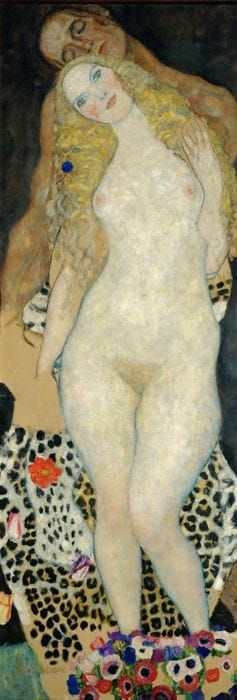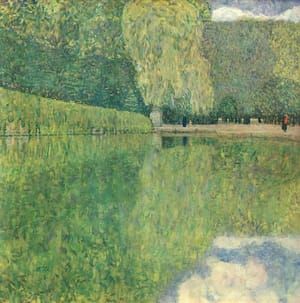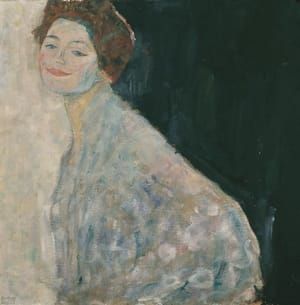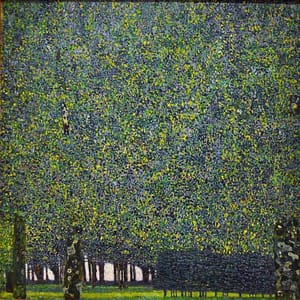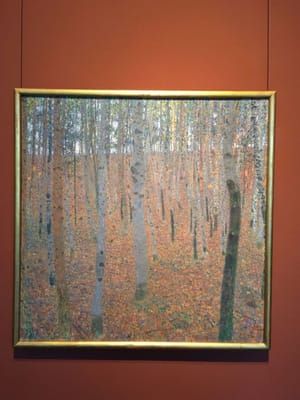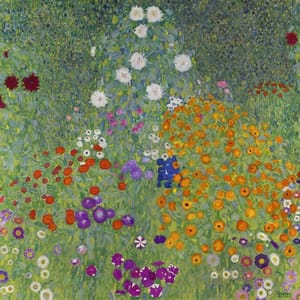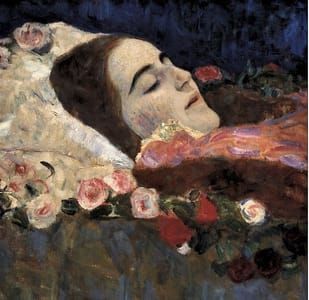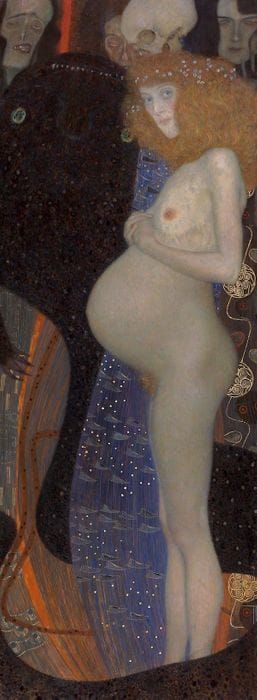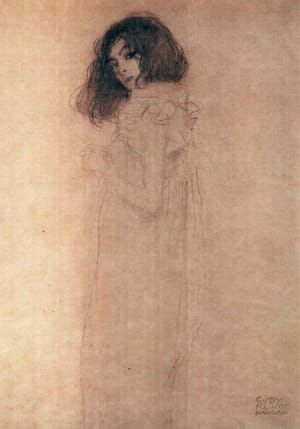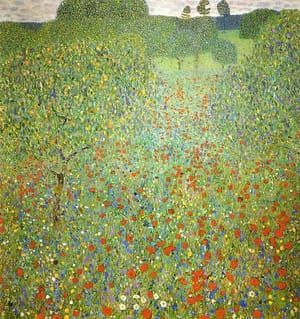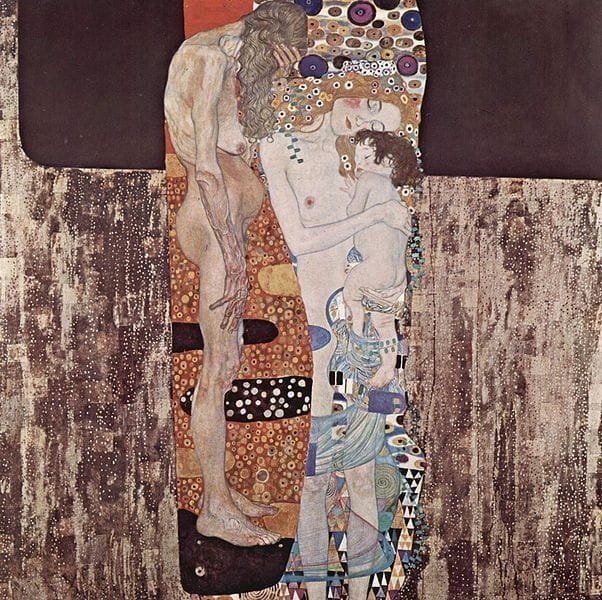

The Three Ages Of Woman, 1905
Gustav Klimt
....sometimes referred to as Mother and Child. The painting is housed in the Galleria Nazionale d’Arte Moderna in Rome. This was one of the artist’s most beloved paintings. For Klimt, although he had painted smaller allegorical pictures, this was to be his first and one of his last multi-figured large-scale allegorical painting, which simply put, is a painting in which there is a pictorial representation of abstract ideas by the depiction of the characters or events in the painting. It is a visual symbolic representation. This painting by Klimt is about the transience of life and the permanence of death.
In the painting we see three women at different stages of life. The youngest is the baby, representing infancy, who in turn is being cradled in the arms of the mother, who although is an adult, is a young adult, representing motherhood. The third figure, on the left of the group is the old woman who represents old age. These three figures have appeared before, slightly altered in form, in some of his earlier and later paintings, such as Medicine which he first exhibited at the 10th exhibition of the Secession Group in Vienna in 1901 and Death and Life which he completed in 1911.
The background of this is a sea of silver bubbles but the three figures are closely surrounded by unusual shapes. So what are the shapes? It is believed that Klimt had a great interest in the science of microbiology and the shapes floating above the head of the younger women resemble colonies of bacteria, whilst the older woman stands amid the elongated protozoa, which is associated with death and decomposition. This painting is about transition – birth to death. It reminds me of the words uttered at a graveside when the coffin is being lowered “while we are in life we are in death”. It is the thought that on the day you are born you start the dying process.
The Old Courtesan by Rodin
Let us first concentrate our gaze on Klimt’s portrayal of the old woman. There is nothing endearing about his depiction of the woman. Some would have us believe that Klimt based his depiction of the old woman on Rodin’s sculpture called The Old Woman. In the painting, the head of the elderly woman is bowed as if she has lost all her strength, both physically and mentally, and the will to carry on with life. She is withering away. Her right arm lies limply by her side. Her breasts have sagged. Her stomach muscles can no longer hold in her belly. The veins and arteries in her hand and arm stand out. Her left hand covers her face and by this gesture we take it that she wants to see no more of life. She wants to close it out. She has had enough. She just wants to hide away from all the trials and tribulations that come with life. In her mind she has lived too long.
The mother with the child in the middle of the group represents beauty and the way she lovingly cradles the baby is a representation of the unconditional love of a mother. See how she rests her head on the head of the child. She is the personification of contentment and this look of contentment is mirrored in the face of the baby as she peacefully sleeps in the knowledge that the arms that hold him and the sound of his mother’s heartbeat offer him safety and affection.
So did the painting receive with universal acclaim? Not really. Many feminists viewed the painting with disdain pointing out that Klimt’s “message” is that a woman’s life is over after the young motherhood stage of life. The overall feel to this painting is one of isolation. The three women look as if they are trapped inside a column surrounded on both sides by a void. After the death of his baby son, Otto, in 1902, Klimt became preoccupied with the subject of death and the passage of life on its unstoppable journey towards death.
This is a truly wonderful and yet disturbing painting and once again I would like to have been in the head of the artist as he painted this picture so as to understand what was going through his mind.
(https://mydailyartdisplay.wordpress.com/2011/06/02/three-ages-of-woman-by-gustav-klimt/)
The work features three women in varying stages of age, symbolizing the cycle of life. The three women are central on the canvas and are the focal point of the work. The background has a lack of depth, making it look very two dimensional. The colors are neutral and create a restful effect. Klimt's common use of colorful motifs is also evident in this work. There are two vertical auras that the women are in. The two younger women are in a blue aura that has a fluid pattern of cool colors. The old woman is in an aura by herself, and it is filled with a less fluid pattern with more distinct separations in the design. The colors of this aura are warm, earthy tones that contrast with the cool colors of the other aura. The woman and the auras overlap slightly. The leg of the young woman goes behind the left aura and the old woman's head comes in front of the right aura.
The youngest figure, a child, is connected to the young woman who is her mother. They are the only two touching, they also have sheer blue fabric draped down their legs. Both of these women also have their eyes closed. The young woman has flowers around her head which represent spring. Her hair is bright an voluminous, contrasting with that of the old woman who is separated from the other two women. Her head is turned away and facing down. The effects of old age are obvious through her sagging skin, bloated belly, and prominent veins. She is also unlike the other two in the fact that both of her feet are shown. This was done so the viewer can see the ugliness of her age in its entirety.
...It shows signs of an impasto painting technique that was common of Klimt's work. His painting methods included mixing drying solvents into the paint to make sure there was no unwanted glossy appearance. He also would retouch works, which limited how many paintings he was able to create per year. The Three Ages of Woman falls into Klimt's Golden Period which includes other works such as The Kiss. This period was characterized by high ornamentation and the use of gold and metallic paints. This work also suggest that it is part of the Art Nouveau movement due to the time period and the decorative elements. The Painting is located in Rome at the Galleria Nazionale d'Arte Moderna.
(https://en.wikipedia.org/wiki/The_Three_Ages_of_Woman_(Klimt))
71 x 71 in
© 1905 Gustav Klimt
Gustav Klimt
artistArthur
coming soon


